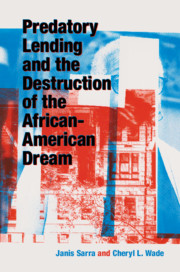Book contents
- Predatory Lending and the Destruction of the African-American Dream
- Predatory Lending and the Destruction of the African-American Dream
- Copyright page
- Dedication
- Contents
- Figures
- Tables
- Foreword
- Acknowledgements
- 1 Introduction
- 2 Foreclosure: At What Cost and to Whom?
- 3 Predatory Lending Practices Prior to the Global Financial Crisis
- 4 Predatory Lending Targeted African Americans
- 5 The Implications of the Collapse of the Mortgage-backed Securities Market for Consumer Borrowers
- 6 A Missed Opportunity
- 7 Financial Crisis Reforms Woefully Inadequate
- 8 Incomplete Justice: Legal Actions against Predatory Lenders
- 9 A Sub-prime Loan by Any Other Name Is Just as Predatory
- 10 “Forgiveness” rather than Forbearance or Foreclosure
- Appendix
- Index
3 - Predatory Lending Practices Prior to the Global Financial Crisis
Published online by Cambridge University Press: 22 June 2020
- Predatory Lending and the Destruction of the African-American Dream
- Predatory Lending and the Destruction of the African-American Dream
- Copyright page
- Dedication
- Contents
- Figures
- Tables
- Foreword
- Acknowledgements
- 1 Introduction
- 2 Foreclosure: At What Cost and to Whom?
- 3 Predatory Lending Practices Prior to the Global Financial Crisis
- 4 Predatory Lending Targeted African Americans
- 5 The Implications of the Collapse of the Mortgage-backed Securities Market for Consumer Borrowers
- 6 A Missed Opportunity
- 7 Financial Crisis Reforms Woefully Inadequate
- 8 Incomplete Justice: Legal Actions against Predatory Lenders
- 9 A Sub-prime Loan by Any Other Name Is Just as Predatory
- 10 “Forgiveness” rather than Forbearance or Foreclosure
- Appendix
- Index
Summary
Chapter 3 examines the predatory and subprime lending that occurred in the years leading up to the collapse of the subprime mortgage market, during which mortgage lenders developed a number of new products with opaque and predatory terms. At the time of the subprime market collapse, 20 percent of homes in the U.S. mortgage market were purchased with subprime loans. A “dual mortgage market” emerged, in which borrowers of colour were served primarily by subprime lenders, while higher-income and white borrowers were served primarily by conventional lending institutions. Even after controlling for differences in borrower and neighbourhood risk characteristics, African-American and Latinx borrowers were more likely to receive subprime loans and/or loans with other risky product features than similarly situated white borrowers. This chapter examines the various mechanisms used in predatory mortgages, including inappropriate and sometimes fraudulent conduct. Many borrowers mistakenly believed the mortgage brokers acted in borrowers’ best interests. These practices and many others created a pernicious downward cycle for African Americans in terms of loss of wealth and of homes.
- Type
- Chapter
- Information
- Publisher: Cambridge University PressPrint publication year: 2020



